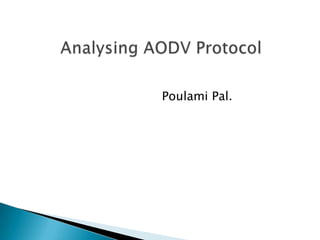
analysins aodv
- 1. Poulami Pal.
- 2. Formed by wireless hosts which may be mobile Without (necessarily) using a pre-existing infrastructure Routes between nodes may potentially contain multiple hops
- 3. Ease of deployment Speed of deployment Decreased dependence on infrastructure
- 4. Personal area networking ◦ cell phone, laptop, ear phone, wrist watch Military environments ◦ soldiers, tanks, planes Civilian environments ◦ taxi cab network ◦ meeting rooms Emergency operations ◦ search-and-rescue
- 5. Ad-hoc Mobile Routing Protocols Table Driven Protocols On Demand Protocols Hybrid Protocols ABR, DSR, AODV, DSDV, TORA WRP ZRP
- 6. Table Driven Routing Protocol ◦ Send periodic updates of the routes. ◦ Each node uses routing information to store the location information of other nodes in the network. On Demand Routing Protocols ◦ Establish routes only when required to route data packets. ◦ Route discovery process ◦ Have longer transmission delays
- 7. AODV is a packet routing protocol designed for use in mobile ad hoc networks (MANET) Intended for networks that may contain thousands of nodes One of a class of demand-driven protocols Each node maintains a routing table that contains information about reaching destination nodes.
- 8. The basic message set consists of: ◦ RREQ – Route request ◦ RREP – Route reply ◦ RERR – Route error ◦ HELLO – For link status monitoring
- 9. RREQ Messages ◦ A RREQ message is broadcasted when a node needs to discover a route to a destination. ◦ The RREQ also contains the most recent sequence number for the destination. ◦ A valid destination route must have a sequence number at least as great as that contained in the RREQ.
- 10. A B? B? B? B? B? B? B? B
- 11. RREP Messages ◦ When a RREQ reaches a destination node, the destination route is made available by unicasting a RREP back to the source route. ◦ A node generates a RREP if: It is itself the destination. It has an active route to the destination. ◦ As the RREP propagates back to the source node, intermediate nodes update their routing tables (in the direction of the destination node).
- 12. A A A A B
- 13. Route Error Message: RERR are used mainly when nodes get moved around and connections are lost. If a node receives a RERR, it deletes all routes associated with the new error. Error messages are sent when a route becomes invalid, or if it cannot communicate with one of its neighbors.
- 14. HELLO Message:These are simple messages that nodes send at certain time intervals to all its neighbors to let them know that it is still there. If a node stops receiving hello messages from one of its neighbors, it knows that any routes through that node no longer exist.
- 15. Source G A RREQ RREQ RREQ RREP RREQ B D RREQ RREP RREQ RREQ RREP F Destination C RREQ RREQ E
- 16. There are two phases ◦ Route Discovery. ◦ Route Maintenance. Each node maintains a routing table with knowledge about the network. AODV deals with route table management. Route information maintained even for short lived routes – reverse pointers.
- 17. Broadcast RREQ messages. Intermediate nodes update their routing table Forward the RREQ if it is not the destination. Maintain back-pointer to the originator. Destination generates RREP message. RREP sent back to source using the reverse pointer set up by the intermediate nodes. RREP reaches source, communication starts.
- 18. Hello messages broadcast by active nodes periodically HELLO_INTERVAL. No hello message from a neighbor in DELETE_PERIOD,link failure identified. A local route repair to that next hop initiated. After a timeout ,error propagated both to originator and destination. Entries based on the node invalidated.
- 19. AODV route discovery latency is high AODV lacks an efficient route maintenance technique AODV lacks support for high throughput routing metrics
